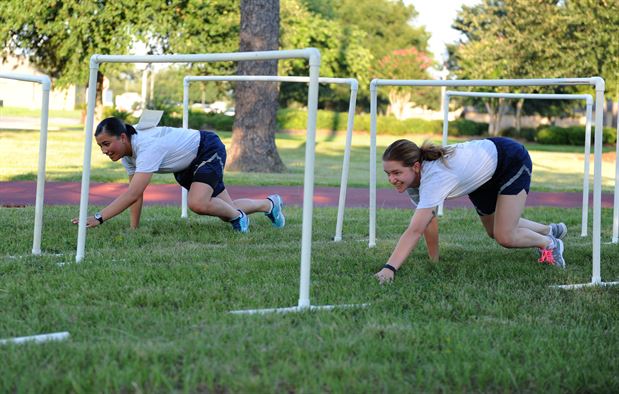Aug 9, 2017Crawl to Fitness
For coaches who are looking for a new way to challenge their athletes, the bear crawl could be a great addition to any workout. Although it’s a seemingly simple exercise, each movement during the bear crawl works the athletes’ core, shoulders, posture, and endurance — without the need for any equipment.
In an article for Hurst Strength, strength and conditioning coach Erica Hurst writes that the bear crawl strengthens the athlete’s core. At the same time, it provides stability to the hips, shoulders and pelvis.
“When we lift our knees off the ground while bear crawling and move forward, we are challenging our core to keep our spine neutral (meaning not overly arched or rounded) and to prevent our hips and pelvis from drooping and rocking from side to side as we shift our weight with each step,” writes Hurst. “In doing so, we also learn how to disassociate hip movement from lower back movement — which is super important for the longevity of our spine and preventing injuries.”

Throughout the exercise, athletes also learn and engrain the correct movement of their body. As Hurst explains, crawling serves as the base for utilizing the proper gait when standing, and this is important for any athlete to be successful at their sport.
“If you have an irregular or inefficient gait, you’re probably not going to have good luck if you try to run, perform single leg exercises or participate in other athletic activities,” she writes. “This is why we learn how to crawl first as babies — because crawling helps prime our bodies for upright activities by teaching our shoulders and hips to work together like they’re designed to, and to develop reflexive strength in our core.”
The benefits of the bear crawl continue, as Molly Galbraith, CSCS, explains in a blog for Girls Gone Strong. She states that this exercise can also be used for increasing full body muscular endurance, increasing the overall health of the shoulders, as well as for conditioning.
In order to gain all of the benefits from this exercise, coaches must make sure that their athletes are doing it correctly. In her blog, Galbraith lays out the steps that an athlete should take in setting up and carrying out the bear crawl:
- Get into a pushup position. Place your hands a little bit wider than shoulder width and slightly turned out.
- Set your feet so they are slightly wider than shoulder width. Place your knees below your hips.
- Position your body so it’s in a straight line from head to hips. Keep your spine in neutral alignment throughout the exercise.
- Walk forward on your hands and feet, taking relatively small, controlled steps.
- Take deep breaths through the nose and into the belly. Exhale through your mouth.
- Crawl for the desired distance.
How far your athletes crawl and the amount of sets they do should be decided by the coach, taking into account the athlete’s familiarity with the exercise as well as their present strength and conditioning levels. According to Galbraith, the bear crawl can be used as a general workout before compound strength exercises, or even at the end of a workout as part of a core circuit.
“You can also make it part of a conditioning circuit,” she writes. “Intermediate lifters might perform 2-4 sets of a 10-25 meter bear crawl.”
Once your athlete has mastered the motions of the bear crawl, there are multiple variations that can be utilized as drills. In an article for Stack.com, Andy Haley, CSCS, describes one drill called 100 Bears. For this, the athlete will bear crawl for 10 yards, do 5 to 10 pushups, and then continue this pattern for 100 yards. Another drill he describes is called the Bear Square.
“Bear crawl 10 yards forward, 10 yards laterally to the left, 10 yards backwards and 10 yards laterally to the right,” he writes. “To make it more difficult, add 10 Push-Ups after each 10-yard increment. Repeat twice in each direction.”
While there are many benefits to the bear crawl, it is important to remember your athletes’ safety when it comes to the environment in which they are doing the exercise. Make sure they are working on a surface that will not injure their hands as they will be in constant contact with the ground. For example, on a hot day, artificial turf, track surface, or blacktop could leave athletes’ hands cut, burned, or blistered.
To see the bear crawl in motion, check out this video from Galbraith.



